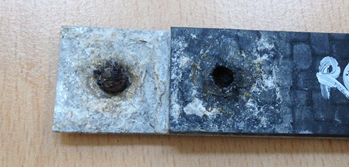By Andre Oliveira
Background
Multi-material constructions are used in a range of industrial sectors to optimise the performance of structures. Focusing on the transport sector, the use of metal-to-carbon fibre reinforced polymer (CFRP) and steel-to-aluminium joints is seeing dramatic growth. As these materials cannot be welded together directly, many industrial joining solutions involve the use of mechanical fastening and/or adhesives. Even with successful joining, however, these dissimilar material combinations remain highly susceptible to corrosion. This stems from the galvanic coupling between the materials, which have greatly differing electrode potentials in the operating environment.
Despite the widespread use of fasteners in these applications, reference to the literature indicates that very little development of fasteners, or coatings for those fasteners, has been performed to mitigate corrosion. In fact, only two strategies are used industrially:
carbon steel fasteners with a zinc coating (zinc flake, zinc nickel or zinc-tin); or austenitic stainless steel fasteners (without a coating).
Furthermore, very little corrosion information is available for mechanically fastened dissimilar joints between carbon fibre composites and metal, and reference to the literature indicates that studies to optimise fastener materials and their coatings have not been performed for metal-to-composite joints. This is in spite of widespread concerns regarding durability. In production cars, for example, dissimilar joints of this type are used almost exclusively in ‘dry’ areas of vehicles, where exposure to water, salt and stone chipping from road surfaces does not occur. To reduce further the risk of corrosion-induced failure, dissimilar material joints in cars are usually coated with sealants, electrolytically deposited zinc-phosphate crystals and multiple layers of paint and lacquer. These measures are taken because if, the paint layers are penetrated and the joints become exposed to electrolytes (moisture, salt water from the road, etc), rapid deterioration of the fastener and thus the joint then occurs.
The focus of this review is therefore to examine fastener-coating developments that can improve the corrosion performance of dissimilar metal to composite joints. Note that coating systems that act as a barrier preventing the electrical interaction between materials can potentially have applications across a range of dissimilar materials combinations, including not only metal to CFRP joints but also aluminium to steel.

Zinc-coated carbon steel rivet in an aluminium to CFRP joint, exposed to 96 hours of salt spray: total rivet failure occurred.